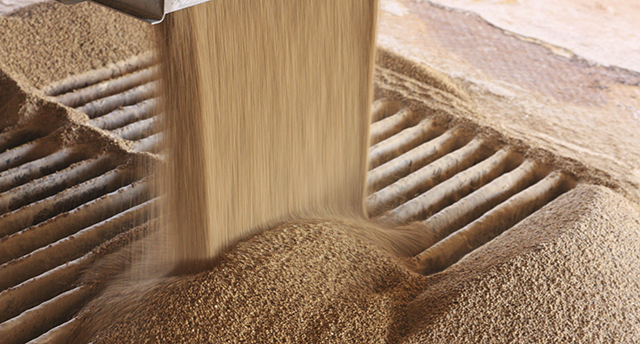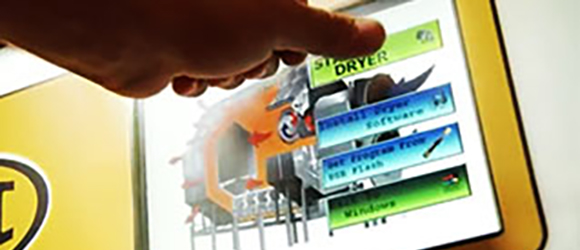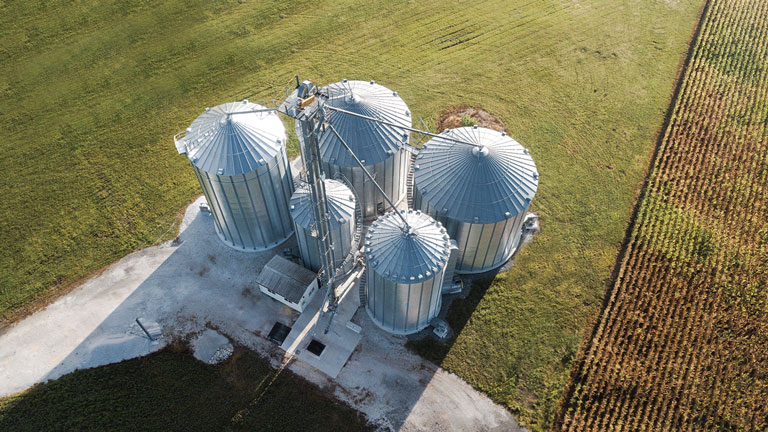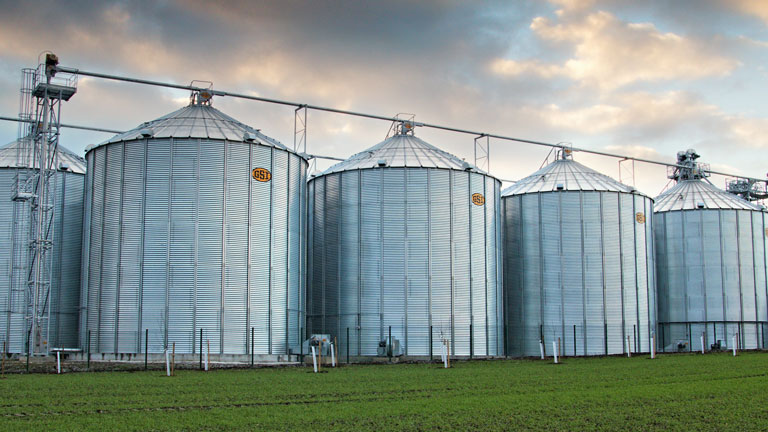
Additional Markets
In addition to grain and feed markets, InterSystems, the brand known as a worldwide manufacturer of bulk material handling equipment and industrial sampling systems, is found on a full range of products in support of other industries.

Sales and Service
Check this area often for updated manuals, software updates and limited time offers.

Resources
Learn more about GSI products and specifications in our brochure library.

About Us
GSI supports agriculture around the globe with the most extensive global manufacturing footprint and dealer network in our industry. We bring our customers local solutions with global expertise.
FAQ
We are providing information for both those familiar with our product and those that are new to GSI Bins. All information and recommendations on this page are intended to be of an advisory nature only. GSI assumes no liability of any type related to the use or application or misapplication of said information.
NARROW (2.66") VS. WIDE (4") CORRUGATION PATTERN
GSI manufactures both Narrow (2.66") and Wide (4") corrugation bins and silos. Neither corrugation has a great theoretical advantage over the other.
The Narrow (2.66") corrugation is the original GSI grain bin line. This series is a popular choice throughout the United States and in several other regions of the world. The 32" (813 mm) tall sheets reduce the weight of each sheet, which eases construction of the larger diameter and taller silos, which utilize thicker gauge steel.
The Wide (4") corrugation is popular in certain area's of the United States and Canada, especially in the smaller diameter and shorter bin heights. GSI began manufacturing the Wide corrugation bin/silo to match up to the eave and peak heights of existing 4" corrugation bins/silos, as well as for the overall appearance. This is often an important factor when adding to an existing facility.
STIFFENED VS. UNSTIFFENED TANKS
GSI manufactures both the stiffened and unstiffened series of bins/silos. The unstiffened series is popular in the United States due to the large number of existing unstiffened bins/silos on the farmsteads. They also have lower erection times.
The stiffened series generally offers more efficient material usage and will generally have a lower material cost and lower freight cost than the comparable size of unstiffened tank. They also offer the advantage of being available in taller bins / silos than the unstiffened series.
BIN VS. SILO TERMINOLOGY
The interchanging use of the term bin and silo as the description for our grain storage structures stems from the international nature of the agriculture. In the U.S. and Canada the term bin is most frequently used to describe corrugated metal structures for the storage and drying of grain. The term silo is most commonly used in these nations for structures meant to store fermented forage products (silage or haylage) or for tall concrete dry grain storage structures or complexes.
Conversely, outside of North America the term silo is almost uniformly used as the terminology for round grain storage structures, including corrugated steel structures.
Our structures are not intended for storage of forage products such as silage that requires a fermentation process to reach the products desired condition.
PAINTING RECOMMENDATIONS FOR OLDER BINS/SILOS
After an extensive period of use, the question sometimes arises what kind of paint could be used to paint an older used bin or for the maintenance of a bin / silo that is in an aggressive environment. The following statement from our engineering archives addresses this point.
Painting of galvanized grain bin shell components and roof panels.
Before painting, the steel surface should be free of all foreign materials such as dirt, white rust, red rust, oil, etc. Wire brushing or needle or brush blasting of corroded areas is recommended.
New, non-corroded galvanized steel will typically have a di-chromate (rust retardant) coating that inhibits paint adhesion. To paint new galvanized steel an abrasive removal process such as wire brushing or sand blasting will be necessary to abrade the di-chromate coating. Natural weathering will remove this coating as well. A minimum of six months would be required for the natural weathering off of the coating.
Once the steel surface has been cleaned, a zinc rich primer should be applied per the manufacturers instructions. Two coats of the zinc rich primer are normally recommended. This primer will have a dull gray appearance. To provide the bright shine and color of new galvanized steel a final coat of a rust inhibiting aluminum paint may be applied over the primer. One manufacturers primer product recommendation follows. Other manufactures may offer similar products.
For touching up small areas zinc rich spray paints marketed as "cold galvanizing compound" or similar identification may be useful. Check with your GSI Dealer for more information.
This is a non-epoxy product with good corrosion resistance, requiring a lesser degree of professional equipment or application than three component epoxy type paints. Contact the particular manufacturer for equivalent primers and aluminum paint numbers / specifications.
Painting of commercial hopper tank steel columns and painted bracing
GSI commercial hopper tank columns are specially cleaned, primed and finish painted. For maintenance painting, the steel surface should be free of all foreign materials such as dirt, red rust, oil, etc. Wire brushing or needle or brush blasting of corroded areas is recommended. Check with your GSI Dealer for equivalent primers and paint numbers / specifications.
IMPORTANT CONSIDERATIONS WHEN ADDING TO EXISTING UNSTIFFENED BINS/SILOS
The following information addresses a number of concerns on the issue of adding to existing farm bins / silos.
"Let's "ADD-ON" to that Old Bin and Save Money"
One frequent request is to "add on to" or "raise" an existing farm bin to increase its storage or drying capacity. While usually possible, certain areas of concern should be covered before proceeding with such a project.
The existing bottom ring will not usually be heavy enough to be kept as the base ring of the taller bin. If the lower edge of the base ring is punched for bolting on new panels, the base ring can be raised with the bin. However, this may require disconnection and disturbance of flooring, transitions, unload equipment, electrical, etc. One alternative is to discard the existing base ring and replace with new panels of the proper type and gage. Another option is to add stiffeners to the bin through the base ring and on into the upper part of the bin. When installing stiffeners on a bin, GSI recommends a minimum of two stiffener columns per sidewall panel. If the stiffeners do not cover the entire height of the bin wall, we recommend staggering their stopping points alternately on the bin. GSI offers our "FC" Farm-Com stiffeners as an economical way to add stiffeners to existing bins.
Existing bin foundations should be checked out for structural adequacy to carry the additional loads of a taller bin.
If the existing bin has some type of flooring system, it should be reviewed to be sure it will withstand the new higher floor pressures of a taller bin.
The existing bin door must either be left in position, moved to a new position with proper sidewall door panels, or replaced with a new door. Be sure the existing door is structurally sound for a possible new location in a taller bin. For example, previous to 1990, GSI did not install the standard two ring door (of that time) in all unstiffened bins / silo heights. Usage of a door from that era and earlier must be limited to it's original design range, or structural problems will result.
Be aware that modification of an existing bin will generally void that bin's warranty from the original bin manufacturer and warranty on new added materials is questionable on some other manufacturer's product.
ROOF DAMAGE FROM INTERNAL AIR PRESSURE AND BLOCKED EXHAUST PORTS
Grain bin roofs can be damaged by internal air pressure from drying / aeration fans running with roof exhaust ports blocked with frost or ice. This can happen to almost any bin roof regardless of size or brand. GSI clearly warns about this potential problem in our catalogs, bin construction manuals and fan manuals.
Anytime fans are moving air through grain and outside temperatures are near or below the freezing mark, the possibility for this problem exists. Years with late harvesting and difficult drying conditions are often associated with running of fans during such weather conditions. Moisture laden air off the grain can form frost and ice on cold metal surfaces such as roof vent screens, roof panels, sidewall panels, etc. If frost accumulation occurs to the point of restricting air flow through vent screens and other air outlets, a build-up of air pressure can push up roof panels and damage the roof.
GSI "wire-grill" roof vents are less prone to frost blockage with our 3/4" wire spacing than many competitors' vents still using 1/2" mesh hardware cloth. The GSI "Auto Vent" is even less likely to frost-plug with the single vent louver providing a large size opening while fans are running. However, no roof vent design can be absolutely guaranteed to never frost over.
The best preventative for this problem is to always have the roof peak cap and roof manway door "OPEN" while running fans during these weather conditions. These door openings will provide adequate exhaust area to prevent roof damaging air pressures.
